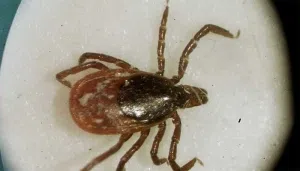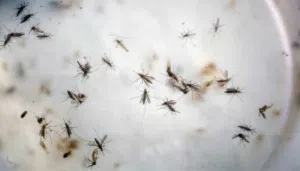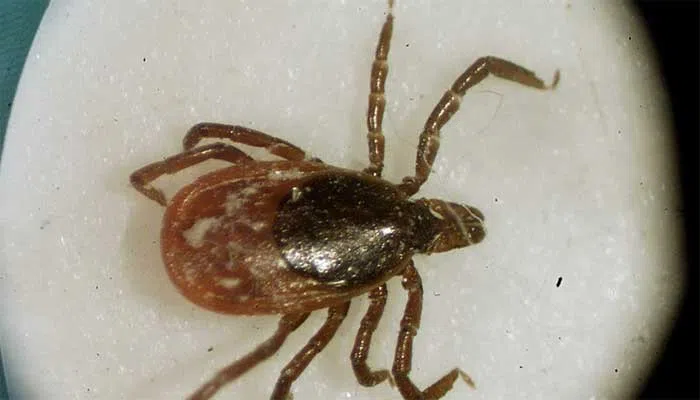 Humans tend to like mild winters. Ticks, not so much.
Humans tend to like mild winters. Ticks, not so much.
Temperate weather tends to kill off ticks, which carry Lyme disease. Fewer ticks means less Lyme disease, a prime example of how weather affects the spread of diseases that are transferred to people by insect bites, said Fordham University biologist Dr. Thomas Daniels.
The news following mild winters is not all good. After moderate winters and early spring rains, mosquito-borne diseases like West Nile Virus and Zika are more likely.
Zika is caused mainly by the bite of an infected Aedes species mosquito, which thrives in hot weather. That’s why the disease was first identified in countries with tropical climates.
The symptoms of Zika are much like the flu, a common cold and other common maladies – fever, rash, joint pain and conjunctivitis, or red eyes.
Most people with Zika do not get sick enough to be hospitalized, but a Zika infection during pregnancy can cause a horrible birth defect called microcephaly, which causes babies to be born with small heads and underdeveloped brains.
Daniels, a New York-based researcher, said that deer ticks, or black-legged ticks, thrive during harsher winters because the insects shut down completely and preserve energy. They are the culprits in Lyme disease outbreaks.
Dr. Chelsea Ward, chair of the biology department at Auburn University Montgomery (Alabama), said that when temperatures consistently hit the 50-degree mark, anything cold-blooded starts to awaken.
“We are seeing frogs and turtles earlier than in the past,” Ward said, adding that the threshold temperature for snakes varies. She is a fan of snakes compared to rats, and says she would rather have one snake than 20 mice.
“Snakes don’t carry diseases like mice and rats,” she said, recalling that rats carried fleas that triggered Europe’s deadly Black Death pestilence.
Roaches, like mice, are another household pest that will be out earlier if temperatures are warmer sooner on the calendar, Ward said. Roaches are dormant in the winter, resting in leaves or rotten wood before becoming active as temperatures rise, she said.
“Roaches will go wherever it’s comfortable and like the same space that we do. If it’s too hot, they come inside. And if it’s too cold, they come inside,” she said.
Spotlight on mosquitoes
Mosquitoes have gained a lot more attention this spring because of Zika, which has gotten a lot of media attention.  The same mosquito that causes Zika can also can carry yellow fever.
The same mosquito that causes Zika can also can carry yellow fever.
Mosquitoes typically lay eggs near standing water, and don’t need much water to breed in, Ward and Daniels said.
“An old soda cup is enough,” Ward said. “Hundreds could breed in an old soda cup.”
Daniels said that the Asian Tiger mosquito, which is common in the U.S., is being watched closely for possible Zika transmission because it carriers a similar virus, the chikungunya virus disease.
With mosquitoes, a lot of rain, or the lack of it, can play a role in the rapid transmission of illnesses.
Daniels said a drought was pivotal in the 1999 spread in New England of the West Nile by the basic northern house mosquito. As the drought intensified in the summer, birds and mosquitoes were brought together in closer quarters at concentrations of water.
The insects bit the birds, who were infected, and then spread West Nile to people. Late summer rains followed, providing the mosquitoes with more areas to breed. The additional insects, as well as the birds, helped transmit the virus more widely.
“Circumstances have to be just right,” Daniels said.
As for Zika, Daniels said that scientists are watching to see if common mosquitoes can contract the Zika virus by biting a person who’s infected.
“The local mosquito would have to bite at the right time, and the Zika virus would have to be fiery, and the mosquito would have to be the right species,” he said, adding that it’s an unlikely circumstance, but it’s still a possibility being monitored.
He said temperatures that are regularly above 65 translate into mosquito activity.
There is now no vaccine to prevent Zika, but the Centers for Disease Control and Prevention (CDC) says there are steps people can take to prevent mosquito bites. Using repellents, wearing long sleeves and pants, emptying containers holding water and keeping windows and doors closed are just some of the suggestions offered by the CDC.
Ticks and Lyme disease
A mild winter can reduce the number of deer ticks that cause most Lyme disease cases, Daniels added.
“A mild winter is bad for ticks and good for us,” Daniels said. “When it’s not very cold (the tick) doesn’t get to take a break and is burning up resources.”
Daniels’ team conducts weekly samplings of ticks, adding that a bad tick year would mean several of the insects per square yard while a sparse tick year translates into one of the insects every 10 square yards.
“When we have lots of ticks we have lots of Lyme disease cases,” Daniels said.
There have been about 30,000 probable Lyme disease cases reported in the U.S. each year from 2007 through 2014, the CDC says. The health agency suggests that using certain repellents while walking along trails in the woods and inspecting the body and clothes after being outside can help prevent ticks from attaching on you. And if they do, get them off before they do any harm.
– Newschannel 6








